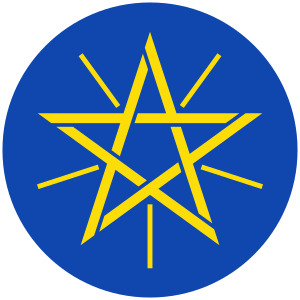1957 Ethiopian general election
General elections were held in Ethiopia in 1957, to elect 210 members of the Chamber of Deputies, the lower house of the Ethiopian parliament (members of the upper house, the Senate, were appointed by the Emperor).[1] These elections followed the new constitution which had been enacted by Emperor Haile Selassie in 1955, and were the first ever held in that ancient country.
 |
|---|
| This article is part of a series on the politics and government of Ethiopia |
|
|
Judiciary |
|
Related topics |
The regulations for this election were set forth in Proclamation 152 of 1952. This law set up a Central Election Board of three members, which worked with the help of the Ethiopian Ministry of Interior.[2] Each rural constituency of 200,000 eligible voters elected two members for the Chamber.[1] Political parties were not authorized at this time, so competition for office were "reduced to the level of individual competition," according to Bahru Zewdu. "Given the attractive salary of deputies as well as the social status enjoyed by them, that competition was understandably keen. Parliament thus became a vehicle for self-promotion rather than a forum of popular representation."[3]
In broad terms, there was universal suffrage for everyone born in Ethiopia and over 21 in age. The prospective voter was required to live in the electoral district for at least one year, not be disqualified by insanity, loss of civil rights pursuant to the penal code law, or be incarcerated.[2] However, candidates had to meet specific property qualifications. According to Edmond Keller, "A candidate had to own at least E$ 850 in land in the constituency he proposed to represent, or he had to possess at least E$ 1,700 in moveable property." Along with the relatively expensive cost of campaigning greatly restricted the number of people who could run for office. As a result, a disproportionate number of candidates were from aristocratic families—26%, according to Edmond Keller.[1]
Electoral arrangements
Provisional information concerning the number of polling stations and electoral districts in the provinces is as follows:[4]
| Province | Polling stations | Electoral districts | Notes |
|---|---|---|---|
| Wollo | 175 | 12 | |
| Shoa | 161 | 11 | |
| Gojjam | 102 | 10 | |
| Eritrea | 121 | 7 | |
| Wollega | 85 | 6 | |
| Tigray | 137 | 5 | |
| Addis Ababa | 30 | 7 | |
| Illubabor | 63 | 2 | |
| Kaffa | 53 | 4 | |
| Arussi | 51 | 4 | |
| Begemder | 122 | 6 | |
| Gamu Gofa | 49 | 10 | |
| Hararge | 93 | 11 |
Voting took place between September 1 and September 30, 1957. Elector's registration between Megabit 1 and Ginbot 30, and candidates' registration between Sene 1 and Hamle 30 (Ethiopian calendar).
References
- Keller, Edmond J. Revolutionary Ethiopia: From Empire to People's Republic (Bloomington: Indiana University Press, 1988), p. 87
- Bereket Habte Selassie, "Constitutional Development in Ethiopia", Journal of African Law, 10 (1966), p. 82
- Bahru Zewde, A History of Modern Ethiopia (second ed.) (Oxford: James Currey, 2001), p. 207
- "Electoral Arrangements". Ethiopia Observer. 1 (7). August 1957.
External links
- "Ethiopia: The Day of Fulfillment", Time magazine, published 11 November 1957